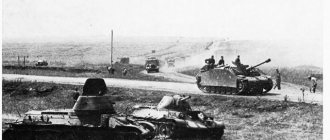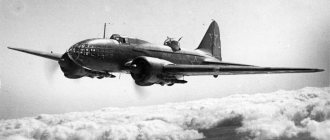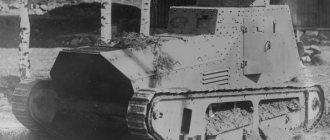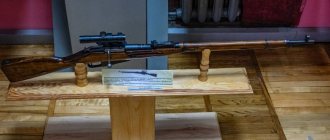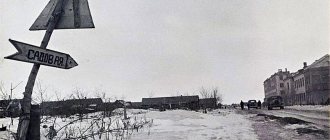The tank that changed the course of the war
On July 8, 1941, a tank battle broke out near the town of Senno, not far from the Dnieper: light Soviet T-26s fought off German T-IIIs. In the midst of the battle, a Russian tank crawled out of the thick rye, crushing potato tops into the ground, the silhouette of which was still unknown to the Germans. “Several German tanks opened fire on it, but the shells ricocheted off its massive turret. There was a German 37mm anti-tank gun on his road. The German artillerymen fired shell after shell at the advancing tank until it crushed their gun into the ground. Then, leaving behind the set fire to the T-III, the tank went 15 kilometers deep into the German defense,” this is how Western historians describe the first appearance of the legendary T-34 tank in the book “From Barbarossa to Terminal.”
Destroyed T-34, June 1942. (wikipedia.org)
For a long time, German designers tried to create a tank that could compete with the 34. This is how the German T-6 Tiger (1942) and T-5 Panther (1943) tanks appeared. However, the German giants still lost to the “best tank in the world,” as the German military leader von Kleist dubbed the T-34, in maneuverability. The brainchild of Mikhail Koshkin, which came off the assembly line of the Kharkov Locomotive Plant, contributed to the development of the so-called “tank fear” among the German troops of the Eastern Front. However, for the designer himself, the invention became fatal: from Kharkov to Moscow, where the tank was supposed to be shown to the management, Koshkin, who had a cold, drove his 34. Having proven that his tank could cover such distances without problems, the designer received severe pneumonia and returned to Kharkov in a semi-conscious state. Having never recovered from the disease, Mikhail Koshkin died in the hospital. This self-sacrifice convinced senior officials to put the tanks into mass production. Before the start of the war, 1,225 T-34 tanks were produced.
In pursuit of the perfect weapon
The goals and objectives set by the government had to be fulfilled.
The country's military production spun up with rapid force. The plan was carried out successfully. In just two or three years, more than 350,000 thousand units of various military equipment were designed and produced. In the pursuit of perfect weapons, the government did not spare its people at all. USSR military equipment was truly expensive. Huge quantities of gold, silver, platinum and diamonds were sold abroad. Large reserves of timber, oil, nickel, manganese and cotton were exported.
The property of churches and museums, libraries and art galleries was sold. Tons of bread were exported abroad. The standard of living of the population fell rapidly, people were starving.
Main woman at the front
The front-line soldiers nicknamed the M-30 howitzer “Mother”, the rockets were initially called “Raisa Sergeevna” (from the abbreviation RS), but most of all they loved, of course, “Katyusha”, the BM-13 field rocket artillery system. One of the first volleys of Katyusha rockets hit the Market Square in the city of Rudnya. The BM-13 made a peculiar sound when firing, in which the soldiers heard Matvey Blanter’s song “Katyusha,” popular before the war. The apt nickname given to the gun by Sergeant Andrei Sapronov spread throughout the army in a couple of days, and then became the property of the Soviet people.
Monument to Katyusha. (wikipedia.org)
The order to start production of Katyushas was signed a few hours before the German invasion. The German troops were the first to use multiple launch rocket systems, trying to destroy the Brest Fortress at the very beginning of the offensive. However, the fortress survived and for a long time the Red Army soldiers who found themselves in it fought against the invaders. The order to start production of Katyushas was signed a few hours before the start of the German invasion. Less than a month later, Soviet troops struck back: in the summer of 1941, the Germans had to get acquainted not only with the new T-34 tank, but also with the hitherto unknown Katyusha. The Chief of the German General Staff, Halder, wrote in his diary: “On July 14, near Orsha, the Russians used weapons unknown until that time. A fiery barrage of shells burned the Orsha railway station and all the trains with personnel and military equipment of the arriving military units. The metal was melting, the earth was burning.”
Monument to the first rocket battery of Captain Flerov. (wikipedia.org)
Rocket launchers, which at the beginning of the war were most often mounted on the chassis of ZIS vehicles, then began to be mounted on anything: from Fords, Dodges and Bedfords received under the Lend-Lease program, to motorcycles, snowmobiles and boats. The operation in which multiple launch rocket systems were used most extensively was the assault on Berlin. Then the “Stalinist organs,” as the Germans called them, fired more than 10 thousand shells and destroyed 120 buildings, where the resistance of the enemy troops was especially fierce.
War of engines: weapons of the Red Army before the start of the Great Patriotic War
Modern war will be a war of engines. Motors on the ground, motors in the air, motors on the water and underwater. Under these conditions, the one who has more engines and a larger reserve of power will win. Joseph Stalin At a meeting of the Main Military Council, January 13, 1941.
During the years of the pre-war five-year plans, Soviet designers created new models of small arms, tanks, artillery, mortars and aircraft. More and more advanced destroyers, cruisers, and patrol ships entered service with the fleet, and special attention was also paid to the development of the submarine fleet.
As a result, before the start of the Great Patriotic War, the USSR had a fairly modern system of weapons and military equipment, and in some tactical and technical characteristics it even surpassed German weapons analogues. Therefore, the main reasons for the defeats of the Soviet troops in the initial period of the war cannot be attributed to miscalculations in the technical equipment of the troops.
TANKS According to data on June 22, 1941, the Red Army had 25,621 tanks. The most popular were the light T-26s, of which there were almost 10 thousand vehicles, and representatives of the BT family - there were about 7.5 thousand of them. A significant proportion were wedges and small amphibious tanks - a total of almost 6 thousand were in service with the Soviet troops. modifications T-27, T-37, T-38 and T-40. The most modern KV and T-34 tanks at that time numbered about 1.85 thousand units.
KV-1 tanks
Heavy tank KV-1
The KV-1 entered service in 1939 and was mass-produced from March 1940 to August 1942. The tank's mass was up to 47.5 tons, which made it much heavier than existing German tanks. He was armed with a 76 mm cannon. Some experts consider the KV-1 to be a landmark vehicle for global tank building, which had a significant impact on the development of heavy tanks in other countries.
The Soviet tank had the so-called classic layout - the division of the armored hull from bow to stern successively into a control compartment, a combat compartment and an engine compartment. It also received an independent torsion bar suspension, all-round anti-ballistic protection, a diesel engine and one relatively powerful gun. Previously, these elements were found separately on other tanks, but in the KV-1 they were brought together for the first time. The first combat use of the KV-1 dates back to the Soviet-Finnish War: a prototype of the tank was used on December 17, 1939 during the breakthrough of the Mannerheim Line. In 1940-1942, 2,769 tanks were produced. Until 1943, when the German Tiger appeared, the KV was the most powerful tank of the war. At the beginning of the Great Patriotic War, he received the nickname “ghost” from the Germans. Standard shells from the Wehrmacht's 37mm anti-tank gun did not penetrate its armor.
Tank T-34
Medium tank T-34 In May 1938, the Armored Directorate of the Red Army invited plant No. 183 (now the Kharkov Transport Engineering Plant named after V. A. Malyshev) to create a new tracked tank. Under the leadership of Mikhail Koshkin, the A-32 model was created. The work proceeded in parallel with the creation of the BT-20, an improved modification of the already mass-produced BT-7 tank.
Prototypes of the A-32 and BT-20 were ready in May 1939; based on the results of their tests in December 1939, the A-32 received a new name - T-34 - and was put into service with the condition of modifying the tank: bringing the main armor to 45 millimeters, improve visibility, install a 76-mm cannon and additional machine guns. In total, by the beginning of the Great Patriotic War, 1066 T-34s were manufactured. After June 22, 1941, production of this type was launched at Gorky (now Nizhny Novgorod), Chelyabinsk Tractor Plant in Sverdlovsk (now Yekaterinburg), plant No. 174 in Omsk and Uralvagonzavod (Nizhny Tagil).
In 1944, serial production of the T-34-85 modification began with a new turret, reinforced armor and an 85-mm gun. The tank has also proven itself well due to its ease of production and maintenance. In total, more than 84 thousand T-34 tanks were manufactured. This model took part not only in the Great Patriotic War, it was in many armed conflicts in Europe, Asia and Africa in the 1950-1980s. The last documented case of combat use of T-34s in Europe was their use during the war in Yugoslavia.
AVIATION By the beginning of the Great Patriotic War, Soviet aviation was armed with many types of combat aircraft. In 1940 and the first half of 1941, almost 2.8 thousand modern vehicles entered the troops: Yak-1, MiG-3, LaGG-3, Pe-2, Il-2. There were also I-15 bis, I-16 and I-153 fighters, TB-3, DB-3, SB (ANT-40) bombers, multi-purpose R-5 and U-2 (Po-2). The new aircraft of the Red Army Air Force were not inferior to the Luftwaffe aircraft in combat capabilities, and even surpassed them in a number of indicators.
Sturmovik Il-2
Il-2 attack aircraft The Il-2 armored attack aircraft is the most produced combat aircraft in history. In total, more than 36 thousand cars were produced. He was called the “flying tank,” the Wehrmacht leadership called him “the Black Death” and “Iron Gustav.” German pilots nicknamed the Il-2 “concrete plane” for its high combat survivability.
The first combat units that were armed with these vehicles were created just before the war. Attack aircraft units were successfully used against enemy mechanized and armored units. At the beginning of the war, the Il-2 was practically the only aircraft that, given the superiority of German aviation, fought the enemy in the air. He played a big role in containing the enemy in 1941. During the war years, several modifications of the aircraft were created. The Il-2 and its further development, the Il-10 attack aircraft, were actively used in all major battles of the Great Patriotic War and in the Soviet-Japanese War. The maximum horizontal speed of the aircraft at the ground was 388 km/h, and at an altitude of 2000 m – 407 km/h. The ascent time to a height of 1000 m is 2.4 minutes, and the turn time at this height is 48-49 seconds. At the same time, in one combat turn, the attack aircraft gained a height of 400 meters.
MiG-3 fighter
Night fighter MiG-3 The design team, headed by A. I. Mikoyan and M. I. Gurevich, worked hard in 1939 on a fighter for combat at high altitudes. In the spring of 1940, a prototype was built, which received the MiG-1 brand (Mikoyan and Gurevich, the first). Subsequently, its modernized version received the name MiG-3.
Despite the significant take-off weight (3350 kg), the speed of the production MiG-3 at the ground exceeded 500 km/h, and at an altitude of 7 thousand meters it reached 640 km/h. This was the highest speed achieved at that time on production aircraft. Due to the high ceiling and high speed at an altitude of over 5 thousand meters, the MiG-3 was effectively used as a reconnaissance aircraft, as well as an air defense fighter. However, poor horizontal maneuverability and relatively weak weapons did not allow it to become a full-fledged front-line fighter. According to the estimates of the famous ace Alexander Pokryshkin, while inferior in the horizontal direction, the MiG-3 was significantly superior to the German Me109 in vertical maneuver, which could serve as the key to victory in a clash with fascist fighters. However, only top-class pilots could successfully fly the MiG-3 in vertical turns and at extreme overloads.
FLEET By the beginning of the Great Patriotic War, the Soviet fleet had a total of 3 battleships and 7 cruisers, 54 leaders and destroyers, 212 submarines, 287 torpedo boats and many other ships.
The pre-war shipbuilding program provided for the creation of a “large fleet”, the basis of which would be large surface ships - battleships and cruisers. In accordance with it, in 1939-1940, battleships of the "Soviet Union" type and heavy cruisers "Kronstadt" and "Sevastopol" were laid down, and the unfinished cruiser "Petropavlovsk" was purchased in Germany, but plans for a radical renewal of the fleet were not destined to come true. In the pre-war years, Soviet sailors received new light cruisers of the Kirov class, leaders of destroyers of projects 1 and 38, destroyers of project 7 and other ships. The construction of submarines and torpedo boats was booming. Many ships were completed during the war, some of them never took part in the battles. These include, for example, the Project 68 Chapaev cruisers and the Project 30 Ognevoy destroyers. The main types of surface ships of the pre-war period: light cruisers of the Kirov type, leaders of the Leningrad and Minsk types, destroyers of the Gnevny and Soobrazitelny type, minesweepers of the Fugas type, torpedo boats G-5, sea hunters "MO-4". The main types of submarines of the pre-war period: small submarines of the "M" type ("Malyutka"), medium submarines of the "Shch" ("Pike") and "S" ("Srednyaya") types, underwater minelayers of the "L" type ( "Leninets"), large submarines of types "K" ("Kreiserskaya") and "D" (Dekabrist).
Kirov-class cruisers
Kirov-class cruisers Light cruisers of the Kirov class became the first Soviet surface ships of this class, not counting the three Svetlana cruisers laid down under Nicholas II. Project 26, according to which the Kirov was built, was finally approved in the fall of 1934 and developed the ideas of the Italian light cruisers of the Condotieri family.
The first pair of cruisers, Kirov and Voroshilov, were laid down in 1935. They entered service in 1938 and 1940. The second pair, Maxim Gorky and Molotov, were built according to a modified design and joined the Soviet fleet in 1940-1941. Two more cruisers were laid down in the Far East; before the end of the Great Patriotic War, only one of them, the Kalinin, was put into operation. Far Eastern cruisers also differed from their predecessors. The total displacement of the Kirov-class cruisers ranged from approximately 9,450-9,550 tons for the first pair to almost 10,000 tons for the last. These ships could reach speeds of 35 knots or more. Their main armament was nine 180mm B-1-P guns mounted in three-gun turrets. On the first four cruisers, anti-aircraft weapons were represented by six B-34 100 mm caliber mounts, 45 mm 21-K and 12.7 mm machine guns. In addition, the Kirovs carried torpedoes, mines and depth charges, and seaplanes. “Kirov” and “Maxim Gorky” spent almost the entire war supporting the defenders of Leningrad with gunfire. "Voroshilov" and "Molotov", built in Nikolaev, took part in fleet operations on the Black Sea. All of them survived the Great Patriotic War - they were destined for a long service. The last of the fleet to leave was Kirov in 1974.
Submarine "Pike"
Submarines of the "Pike" type "Pikes" became the most popular Soviet submarines of the Great Patriotic War, not counting the "Malyutoks".
Construction of the first series of four submarines began in the Baltic in 1930; the Pike entered service in 1933-1934. These were medium-class submarines with an underwater displacement of about 700 tons, and their armament consisted of six 533-mm torpedo tubes and a 45-mm 21-K cannon. The project was successful, and by the beginning of the Great Patriotic War, more than 70 Shchukas were in service (a total of 86 submarines were built in six series). Submarines of the Shch type were actively used in all naval theaters of war. Of the 44 Shchuk that fought, 31 were killed. The enemy lost almost 30 ships from their actions.
Despite a number of shortcomings, the “Pikes” were distinguished by their comparative cheapness, maneuverability and survivability. From series to series - a total of six series of these submarines were created - they improved their seaworthiness and other parameters. In 1940, two Shch-class submarines were the first in the Soviet fleet to receive equipment that made it possible to fire torpedoes without leaking air (which often unmasked the attacking submarine). Although only two Shchukas of the latest X-bis series entered service after the war, these submarines remained in the fleet for a long time and were decommissioned in the late 1950s.
ARTILLERY According to Soviet data, on the eve of the Great Patriotic War the army had almost 67.5 thousand guns and mortars.
It is believed that Soviet field artillery was even superior to German in terms of combat qualities. However, it was poorly equipped with mechanized traction: agricultural tractors were used as tractors, and up to half of the implements were transported using horses. The army was armed with many types of artillery pieces and mortars. Anti-aircraft artillery consisted of guns of 25, 37, 76 and 85 millimeters; howitzer - modifications of caliber 122, 152, 203 and 305 millimeters. The main anti-tank gun was the 45mm model 1937, the regimental gun was the 76mm model 1927, and the divisional gun was the 76mm model 1939.
An anti-tank gun fires at the enemy in the battles for Vitebsk
45-mm anti-tank gun model 1937 This weapon became one of the most famous representatives of Soviet artillery of the Great Patriotic War. It was developed under the leadership of Mikhail Loginov based on the 1932 45 mm gun.
The main combat qualities of the 45-millimeter included maneuverability, rate of fire (15 rounds per minute) and armor penetration. By the beginning of the war, the army had more than 16.6 thousand guns of the 1937 model. In total, over 37.3 thousand of these guns were produced, and production was curtailed only by 1944, despite the presence of more modern models of the ZiS-2 and the similar caliber M-42.
Salvo "Katyusha"
“Katyusha” rocket artillery combat vehicle The day before the start of the Great Patriotic War, the BM-13 rocket artillery combat vehicle, which later became known as “Katyusha,” was adopted by the Red Army. It became one of the world's first multiple launch rocket systems.
The first combat use took place on July 14, 1941 near the railway station in the city of Orsha (Belarus). A battery under the command of Captain Ivan Flerov destroyed a concentration of German military equipment at the Orsha railway junction with volley fire. Due to its high efficiency of use and ease of production, by the autumn of 1941 the BM-13 was widely used at the front, having a significant impact on the course of hostilities. The system made it possible to fire a salvo with the entire charge (16 missiles) in 7-10 seconds. There were also modifications with an increased number of guides and other versions of the missiles. During the war, about 4 thousand BM-13s were lost. In total, about 7 thousand units of this type were manufactured, and the Katyushas were discontinued only after the war - in October 1946.
SMALL ARMS Despite the widespread introduction of tanks and aircraft and the strengthening of artillery, infantry weapons remained the most widespread. According to some estimates, if in the First World War losses from small arms did not exceed 30% of the total, then in the Second World War they increased to 30-50%. Before the Great Patriotic War, the supply of rifles, carbines and machine guns to the troops was growing, but the Red Army was significantly inferior to the Wehrmacht in terms of the number of automatic weapons such as submachine guns.
Snipers Rosa Shanina, Alexandra Ekimova and Lidiya Vdovina (from left to right). 3rd Belorussian Front
Mosin rifle Adopted in 1891, the 7.62 mm Mosin rifle remained the main weapon of the Red Army infantryman. In total, about 37 million of these rifles were produced.
Modifications of the 1891/1930 model had to fight during the most difficult months of the beginning of the Great Patriotic War. Thanks to its low cost and reliability, the weapon outperformed its young self-loading rivals. The latest version of the “three-line” was the 1944 model carbine, distinguished by the presence of a permanent needle bayonet. The rifle became even shorter, the technology was simplified, and combat maneuverability increased - with a shorter carbine it is easier to conduct close combat in thickets, trenches, and fortifications. In addition, it was Mosin’s design that formed the basis for the sniper rifle, which was put into service in 1931 and became the first Soviet rifle specifically designed for “sharp shooting and primarily destroying enemy command personnel.”
Soviet and American soldiers. Meeting on the Elbe, 1945
The PPSh Shpagin submachine gun, 7.62 mm caliber, was put into service in 1941.
This legendary weapon has become part of the image of a victorious soldier - it can be seen in the most famous monuments. The PPSh-41 fell in love with the soldiers, receiving from them the affectionate and respectful nickname “daddy.” It fired in almost any weather conditions and was relatively inexpensive. By the end of the war, about 55% of the fighters were armed with PPSh. In total, about 6 million pieces were produced.
IL-2, "Cement Bomber"
The most popular combat aircraft in history, which for a long time was the Il-2 attack aircraft, seems to have become a record holder for the number of nicknames. “Concrete plane” - that’s what the German pilots called it: the Il-2 had poor maneuverability, but it was very difficult to shoot it down. The pilots even joked that the IL-2 could fly “on half a wing, and on my word of honor.” Wehrmacht ground troops, seeing it as a constant threat, called the plane the “butcher” or “Iron Gustav.” The designers themselves simply called the IL-2 a “flying tank.” And in the Red Army, the plane received the nickname “humpback” due to the unusual shape of the hull.
In this form, the Il-2 flew to the airfield. (wikipedia.org)
The first production aircraft "Il-2" was produced on March 10, 1941 at the Voronezh aircraft plant, since then 36,183 of the same attack aircraft have risen above the ground. However, at the time the war began, the Red Army had only 249 vehicles at its disposal. Initially, Ilyushin, the chief designer, created a two-seat “armored attack aircraft”, but after the first tests it was decided to install an additional gas tank instead of the second seat.
All the time, the Soviet command lacked specialized combat aircraft. This is largely why the IL-2, being the most common vehicle, was used for different tasks. For example, a mandatory bomb load was established for all Il-2 aircraft, which was jokingly called the “Stalin outfit”. In addition to bombing, the Il-2 was used, despite its impressive dimensions, as a reconnaissance aircraft. One of the interesting features of the attack aircraft is that the pilots, if the aircraft caught fire in combat, often landed the aircraft on its “belly” without releasing the landing gear. The most difficult thing for the pilot was to get out of the fuselage in time and escape before the IL-2 exploded.
Goals and objectives
The government set several tasks for the designers:
- Improvement of existing weapons and equipment of the USSR.
- Creation in the next two years of the most modern, efficient and powerful models of aircraft, tanks, and artillery installations.
- The introduction of these samples into the Russian army in the shortest possible time.
- Creation of new small arms, machine guns, mortars.
War time
At the cost of the health and lives of millions of Russian people, the country's combat power grew even during the difficult war years.
The development of technology in the USSR continued. During wartime, thanks to the titanic labor of the people, the pace of production rapidly increased. More than 136,000 thousand aircraft, more than 100,000 thousand tanks, and about half a million small arms were produced.
Let us briefly consider what the USSR safety technology was.
Artillery and missile systems
- Mobile missile system S-300VM "Antey-2500" (Russia)
- Anti-aircraft self-propelled gun ZSU-23-4 “Shilka” (Russia)
- Anti-aircraft missile system MIM-104 Patriot (USA)
- Anti-aircraft missile system AN/TWQ-1 Avenger (USA)
- Anti-aircraft self-propelled gun M163 Vulcan (USA)
- Self-propelled artillery unit PzH-2000 (Germany)
- Self-propelled artillery unit CAESAR (France)
- Self-propelled artillery unit FH77 BW L52 Archer (Sweden)
Technology in the post-war period
After the end of the war, the USSR continued to develop its technical and military potential.
It was at this time that such types of automatic and artillery weapons as the Kalashnikov assault rifle, self-propelled gun battery, Simonov carbine, updated Goryunov machine gun, Degtyarev light machine gun, and various mounted anti-tank grenade launchers were designed. New types of effective and powerful armored vehicles have appeared: the PT-76 amphibious tank, the T-54 medium tank, the IS-4 heavy tank, the T-10.
In the aviation field, the Yak-25 fighter-interceptor, SU-17, SU-7b bombers, as well as AN-8, AN-12, AN-22 military transport aircraft were produced.
The ground forces received such missile systems as Osa, Kub, Krug, Strela-2, and Strela-3.
The USSR rapidly developed its combat potential, and the military power of our country was no longer inferior to European countries, China and the USA.
Mitsubishi A6M Zero
Unlike other models presented in this rating, the Misubishi A6M Zero is a carrier-based fighter. The appearance of such an aircraft was due to the large fleet that Imperial Japan possessed. Before the end of World War II, the industry produced over 11 thousand copies of the Zero. Moreover, the latest versions were used for kamikaze attacks.
Zero was capable of reaching speeds of up to 500 km/h. To take off, the plane required a platform of 70 meters. Zero could rise to an altitude of up to 4 kilometers, flying for eight hours without refueling.
The Japanese fighter was equipped with bombs, a machine gun and small arms. The Zero became famous due to the attack on Pearl Harbor in 1941.
Junkers Ju 87
The Junkers Ju-87 is a dive bomber and attack aircraft with a two-seat cabin and one engine. The German model was distinguished by its “inverted gull” wing. Due to this configuration and in combination with the fixed landing gear, the German bomber emitted a characteristic roar during a dive.
The Junkers U-87 was characterized by low speed and a small power reserve. But, despite such characteristics, this device was considered one of the best bombers of Nazi Germany due to its throwing accuracy.
The Junkers Yu-87 was produced in 10 modifications from 1937 to 1944. During this period, German industry produced more than 5.7 thousand bombers. Engineers also created several specialized versions of the Junkers Ju-87, designed to destroy tanks, ships and other military equipment.
